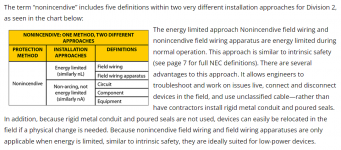I am trying to determine whether or not an equipment upgrade we are planning to implement to our existing equipment will necessitate the use of an intrinsic barrier device. We are adding a bank of 3 or 4 connectors to the side of the equipment in order to electrically connect to some remote boxes (each up to 100 feet away) that will be attached via cable to the box's internal gas flow meters. While the meters each provide 4-20mA back, they are flexible configuration devices and as such require a 3-wire connection that uses vsup (24V) and gnd.
This mobile (immobile during energization/use) natural gas field service equipment currently has 2 LEL detection devices, one inside the equipment enclosure with other electronic devices per 500.7(K)(4), and the other located outside the enclosure, but on the chassis of the equipment that, presumably, can sometimes achieve Inadequate Ventilation (500.7(K)(2)) due to its potential to be in a semi-enclosed configuration whereby the doors come down and surround most of the piping which the NG is routed through before we individually meter it.
Before I spend $80 to buy C22.2 #213-17 and decide if there's verbiage that grants me something nonincendive, does the exterior LEL sound like its alarming capabilities could permit me to not use a barrier? I say the exterior one instead of the interior one because I am assuming its exposure to gas would occur first.
Also, the flow meters are 18-30Vdc, <100mA each. Each "box" is comprised of 4 meters. In an ideal world, maybe it would be nonincendive somehow already, because we sure are running out of space inside these equipment enclosures, and I am already having to allocate a large chunk of what little remaining DIN we have left to accommodate the AI for this upgrade.
Thanks for any opinions on the matter!
This mobile (immobile during energization/use) natural gas field service equipment currently has 2 LEL detection devices, one inside the equipment enclosure with other electronic devices per 500.7(K)(4), and the other located outside the enclosure, but on the chassis of the equipment that, presumably, can sometimes achieve Inadequate Ventilation (500.7(K)(2)) due to its potential to be in a semi-enclosed configuration whereby the doors come down and surround most of the piping which the NG is routed through before we individually meter it.
Before I spend $80 to buy C22.2 #213-17 and decide if there's verbiage that grants me something nonincendive, does the exterior LEL sound like its alarming capabilities could permit me to not use a barrier? I say the exterior one instead of the interior one because I am assuming its exposure to gas would occur first.
Also, the flow meters are 18-30Vdc, <100mA each. Each "box" is comprised of 4 meters. In an ideal world, maybe it would be nonincendive somehow already, because we sure are running out of space inside these equipment enclosures, and I am already having to allocate a large chunk of what little remaining DIN we have left to accommodate the AI for this upgrade.
Thanks for any opinions on the matter!
Last edited:


